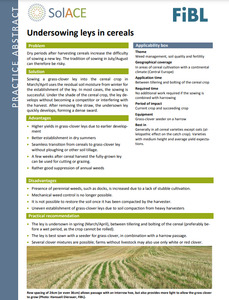{Tool} Undersowing leys in cereals (SolACE Practice abstract). Creator(s): Dierauer, Hansueli and Gelencsér, Tobias. Issuing Organisation(s): FiBL - Research Institute of Organic Agriculture. SolACE Practice abstract. (2019)
|
PDF
- English
(Undersowing leys in cereals (SolACE Practice abstract))
346kB | |
![[thumbnail of 2023-01-09 16_11_51-Undersowing leys in cereals.png]](/41887/3.hassmallThumbnailVersion/2023-01-09%2016_11_51-Undersowing%20leys%20in%20cereals.png)  Preview |
Image (PNG)
- Cover Image
- English
243kB |
Document available online at: https://zenodo.org/record/3529114#.YSdbhY4zaUk
Summary
Advantages
- Higher yields in grass-clover leys due to earlier development
- Better establishment in dry summers
- Seamless transition from cereals to grass-clover ley without ploughing or other soil tillage.
- A few weeks after cereal harvest the fully-grown ley can be used for cutting or grazing.
- Rather good suppression of annual weeds
Disadvantages
- Presence of perennial weeds, such as docks, is increased due to a lack of stubble cultivation.
- Mechanical weed control is no longer possible.
- It is not possible to restore the soil once it has been compacted by the harvester.
- Uneven establishment of grass-clover leys due to soil
compaction from heavy harvesters
Practical recommendation
- The ley is undersown in spring (March/April), between tillering and bolting of the cereal (preferably be-fore a wet period, as the crop cannot be rolled).
- The ley is best sown with a seeder for grass-clover, in combination with a harrow passage.
- Several clover mixtures are possible; farms without livestock may also use only white or red clover.
Remarks and advice
- The denser and higher the cereal crop, the less likely the undersown ley will succeed (due to shading).
- The success of a ley depends greatly on the choice of cereal variety and the yield expectations: Varieties with - more planophile (horizontal) leaf position are better at suppressing weeds; however, this can suppress ley growth due to light limitations.
- Varieties with erectophile leaf positions are better suited (but they also promote weed growth).
- Long-stem plants create more shade for weeds and but also may suppress the ley compared to middle- or short-stem varieties.
- If weeds that spread by roots or rhizomes such as docks or common couch are present, undersowing is not recommended.
- Sow in early spring
Practical testing
- If this method seems to be suitable for your farm, we recommend that you test it under your own farm conditions as follows:
1. When sowing the cereal, delimit a part of the field for testing.
2. Apply the new method on one of the two plots. The other plot can be cultivated as usual to compare.
| EPrint Type: | Practice tool |
|---|---|
| What problem does the tool address?: | Dry periods after harvesting cereals increase the difficulty of sowing a new ley. The tradition of sowing in July/August can therefore be risky. |
| What solution does the tool offer?: | Sowing a grass-clover ley into the cereal crop in March/April uses the residual soil moisture from winter for the establishment of the ley. In most cases, the sowing is successful. Under the shade of the cereal crop, the ley de-velops without becoming a competitor or interfering with the harvest. After removing the straw, the undersown ley quickly develops, forming a dense sward. |
| Country: | Switzerland |
| Type of Practice Tool: | Practice abstracts |
| Keywords: | undersowing, cereal crops, weed control, soil quality, soil fertility, Abacus, FiBL10103 |
| Agrovoc keywords: | Language Value URI English undersowing http://aims.fao.org/aos/agrovoc/c_29253 English cereal crops http://aims.fao.org/aos/agrovoc/c_25512 English weed control http://aims.fao.org/aos/agrovoc/c_8345 English soil quality http://aims.fao.org/aos/agrovoc/c_a9645d28 English soil fertility http://aims.fao.org/aos/agrovoc/c_7170 |
| Subjects: | Soil > Soil quality Crop husbandry > Production systems > Cereals, pulses and oilseeds Crop husbandry > Weed management Crop husbandry > Post harvest management and techniques |
| Research affiliation: | Switzerland > FiBL - Research Institute of Organic Agriculture Switzerland > Crops > Arable crops > Cereals Switzerland > FiBL - Research Institute of Organic Agriculture Switzerland > Crops > Anbautechnik European Union > Horizon 2020 > SolACE |
| Horizon Europe or H2020 Grant Agreement Number: | 727247 |
| Related Links: | https://zenodo.org/record/3529114#.YSdbhY4zaUk, https://www.solace-eu.net/, https://organic-farmknowledge.org/tool/41887, https://www.facebook.com/organicfarmknowledge/posts/325369976042310, https://twitter.com/farm_knowledge/status/1431170127475744769 |
| Project ID: | ofk |
| Deposited By: | Forschungsinstitut für biologischen Landbau, FiBL |
| ID Code: | 41887 |
| Deposited On: | 26 Aug 2021 09:28 |
| Last Modified: | 09 Jan 2023 15:12 |
| Document Language: | English |
| Status: | Published |
Repository Staff Only: item control page

 Download Statistics
Download Statistics Download Statistics
Download Statistics
